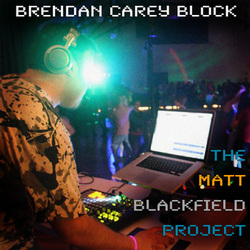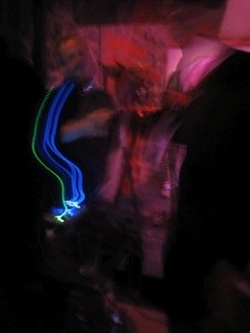|
While many people (me included) attend both sorts of events, it is rather patently obvious that techno contras and traditional contras are somewhat different beasts. While there are general differences in ambiance and potentially in audience, the biggest and most obvious difference is the music: traditional contras generally have live bands playing music that either they composed/arranged themselves, or that has been passed down for generations through the folk process. Crossover contras frequently experiment with contra dancing to music that has been both recorded and possibly remixed. While some DJs work completely with their own material, frequently this involves using others’ intellectual property which, if created after 1923, probably has an interested copyright holder behind it.
 _Back in September when I talked to Julie Vallimont (of Nor'easter and Double Apex), I learned that the other half of Double Apex, Brendan Carey Block, had been performing his own experiments with techno music. Like any curious person of the digital age, I consulted Google to learn more. What I found was not only that Brendan, the 2000-2001 U.S. National Junior Scottish Fiddle Champion, had recently parted ways with contra bands Annalivia and Matching Orange to pursue other projects, but that one of those other projects was DJing under the moniker Matt Blackfield. Further, earlier this year, The Matt Blackfield Project was released for digital download. The Matt Blackfield Project is a rather eclectic blend of folk flavoring and evocative electronic techno. All of the tracks create lush soundscapes, and if I was more inclined as a visual artist, I might have been reaching for some paint and a canvas (and created very different pieces to suit each track's mood). To wit: the collection opens with a watery, echoey rendition of "Fingal's Cave," which the liner notes tell us is an ancient Scottish march with some modern treatment. The addition of the enigmatic, echoey spoken-word passage from Lewis Carroll's Alice in Wonderland made my inner literature geek smile and adds another dimension to the piece. The sixth track, "Short Road, Long Journey," opens with a keyboard loop before introducing more mechanical effects and bells that sound a bit like a rushing crowd. It then shifts to a lower variant of the melody and then weaves a bunch of layers together before it fades out and leaves the distinct impression that the listener has just glimpsed a scene that will continue even after it becomes inaudible. My favorite track, however, is "Dark Field," which frankly to me sounds like a group of pixies decided to crash into the titular field and hold a rave; it opens with cricket-like noises and night sounds, then adds some sparse but reverberating keyboard and then a thumping beat and some steadier, higher-toned drums. Interestingly, it isn't until relatively late in The Matt Blackfield Project's eleven tracks that we hear a lot of the fiddle playing for which Brendan has up until now been known. Both "Soda Springs" and "Leaving Lake Morey" are square (or nearly so) tunes that feature the fiddle heavily and remind me a bit of Perpetual e-Motion's work. For "Leaving Lake Morey," Brendan notes in the liner notes that it was composed "for [his] departure from the fantastic community at the lakeside Hulbert Outdoor Center" and the sense of farewell and longing in this piece is rather clear. "Soda Springs," on the other hand, features some hot fiddle action with some equally hot guitar sounds and framed very well by a backing drum loop. While this is very much an electronic album, The Matt Blackfield Project still shows off Brendan's folkie roots (I was a bit surprised to figure out that about half the tunes are square, or exceedingly close to it) and provides for a foray into the full spectrum of the multidimensional, if somewhat disjointed, world this Project has created. The Matt Blackfield Project is available for digital download at Brendan Carey Block's web site and is also streamable from his Facebook page and his Myspace. _Dennis Gagaoin (pronounced "GA-ga-win") was looking though Spokane, WA's Craigslist when he came across an ad looking for an event DJ. "What caught my attention was the emphasis on electronica music, which is what I am particularly fond of spinning," he explains. In fact, DJ Gaga used to host "Spintronica" on radio station KYRS. "Little did I know that it was for a contra dance until Terra Price contacted me about the details." The event in question was Spokane's Deca-dance, held on October 29 and called by Ray Polhemus. I had never even heard of a techno contra but the idea intrigued me, and when I researched it online and saw videos of techno contra events in other parts of the country, I was extremely excited to DJ the event. I thought it was a great concept and I knew I had to be a part of it."
 DJ Nu B; photo by Silversauce With its new season starting, the Club Contras series in Greenwood, VA found itself looking for some new DJ talent to supply the music for dances. Last month, Brian “DJ Nu B” Murphy made his Club Contras debut. I caught up with him and talked to him about his tunes, his other musical endeavors, and the inspiration he brings and communicates with his DJ skills. It seems that these days North Carolina is a hotbed of crossover contra series, as there appear to be not one but three groups (that I’m aware of -- there may be more!) having events on a fairly regular basis. One of these is Electric Camel Contra, where DJ Eileen Thorsos and her internationally-flavored “electrotrad” music are based.
Eileen herself describes her music as follows: “I focus my DJing on (awesome!) fusion music: traditional tunes played on bagpipes, fiddle, accordion, whistles, etc. and arranged with a lot of beat, electric instrumentation, and other excellent non-traditional arrangements. I've drawn most heavily on the Peatbog Faeries, Shooglenifty, and the Afro Celt Sound System, with important contributions by Martyn Bennett & Martin Low, Enter the Haggis, Urban Trad, Richard Wood, and others....I look for Celtic fusion music that I like (hopefully LOVE), that I want to dance to, and that is upbeat with a rich and interesting sound. I want the dance to be joyous. Many of the sets aren't precisely square the whole way through: They just have to have the potential to be square. I can cut, copy, and paste to make it work out.” On June 4, Club Contras caller and organizer Brian Hamshar and Sheldon “DJ Shel D” Lieberman debuted Technophoria, a techno contra event that they now plan to expand into a series; while the first one was in Asheville, NC, they’re looking at possibly making it a floating series in different venues. Unlike some others, this series uses a seasoned professional DJ to mix the tunes. I caught up with DJ Shel D to see what he had to say about the experience and what drove the idea of Technophoria.
“The idea behind Technophoria as an event came about because of my experience at a contra dance where they ‘experimented’ with contra dancing to alternative styles of music. With my previous experience as a studio DJ (mixing music at a local radio station in Brattleboro, Vermont) I knew that I could professionally mix and produce a show, and take ‘Techno Contra’ into the mainstream of contra dancing. The prospect of contributing to the evolution of contra and be the person to set the new standard in Techno Contra got me very excited!” I sat down a few weeks ago with caller Anna Rain as she supped with the band Morning Star (incidentally, also the source of Brendan Taaffe's sound bite from the earlier blog post) and talked to her about the experience of calling Contra Sonic in February, held in the historic Glen Echo Park Spanish Ballroom. She has been active in the DC-area folk community for many years and while I knew she called, I also know that she's more active in the morris/rapper and English Country Dance traditions than contra dancing, traditional or otherwise. What, then, brought her to try her hand at calling for the local techno contra series?
Club Contras is a crossover contra dance series founded early this year and called by Brian Hamshar. Brian's brother, Clayton "DJ Solar Sound" Hamshar, is their house DJ, spinning tunes for the series every month with some production help from his partner, Forest "DJ FML" Lyon. Together, DJ Solar Sound and DJ FML are known as The System.
Club Contras started as the brainchild of the brothers Hamshar: "Brian and I had been talking about how cool it would be since around 2006-2007. Then, when Contra Sonic popped up [in Washington, DC], Brian was inspired to start one of our own. I was very enthusiastic for the idea, just as much as I had been a few years ago if not more, and so we entered as partners." One of the main ways that techno contras in particular differ from regular contra dances is that they tend to use DJs spinning recorded music instead of having a live band. I sat down with Washington, D.C.-area based Jeremiah "dJ improper" Seligman, who spins for Contra Sonic every month, to talk about his experience.
(Click "Read more" at right to see what he had to say!) |
This project has concluded as of mid-2013 (with an epilogue posted mid-2016) but we hope to see you soon on a contra dance floor! Meanwhile, head over to our Facebook page for upcoming techno contra events and other items of interest.
The 100+ Friday Flourish videos can still be found on YouTube. AuthorI dance with abandon. I play with glowsticks. I look for music that is conducive to one or both. I play behind cameras. I write about all of the above. I'm based in Glen Echo's contra dance community outside of Washington, D.C., but I'm happy to go dance afield when I can. Lather, rinse, repeat. Always repeat. Archives
June 2016
Categories
All
Comments are welcome; spam-bots and disrespectful behaviors are not. Please do (nicely) point out errors if they are found.
|
|
